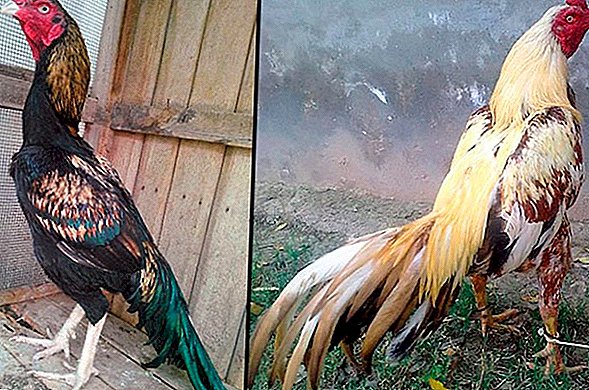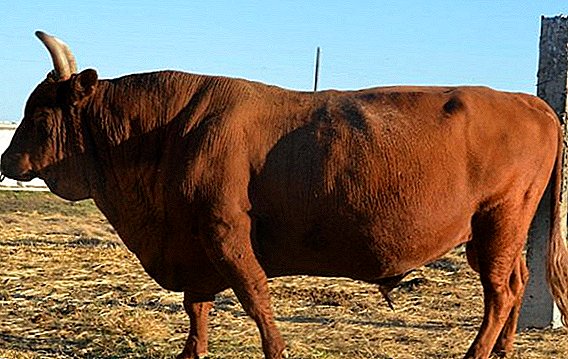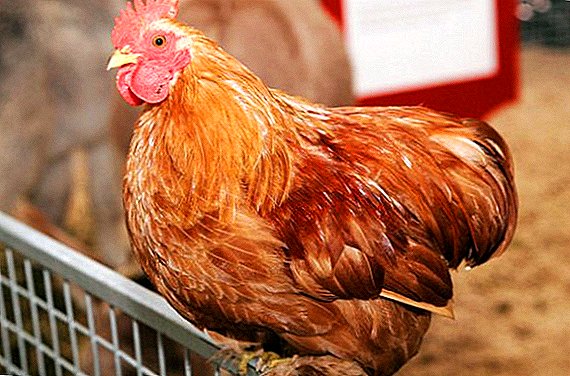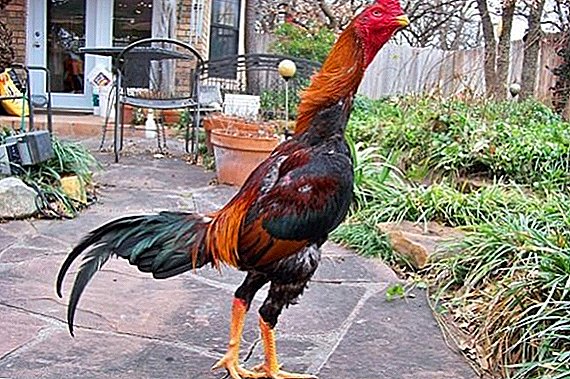 Breed of chickens Azil is one of the most popular fighting breeders among breeders. Indeed, thanks to its excellent physical data, endurance, courage and fearlessness, its representatives often leave the battle victorious. Let's learn more about these birds and get acquainted with the peculiarities of their content and training.
Breed of chickens Azil is one of the most popular fighting breeders among breeders. Indeed, thanks to its excellent physical data, endurance, courage and fearlessness, its representatives often leave the battle victorious. Let's learn more about these birds and get acquainted with the peculiarities of their content and training.
Breed history
The birthplace of the Azil chickens (English Aseel) is India. Approximately 4 thousand years ago, all fighting cocks were called by this name, but later Azil was separated into a separate breed. It only got to Europe (first to Germany) in 1860.
Today, the breed is very popular with fans of fighting birds, because it lends itself well to training and is able to win several battles in a row.
Important! According to the standards of the breed "Azil", an excessively long tail of its representatives is a flaw. The unacceptable disadvantages also include: tall, fluffy plumage, short shoulders and a small body.
External data and physique
There are two types of azil, differing in their size. The first type includes birds cut - miniature individuals weighing 2-3 kg. To the second - several at once: Madras, South Indian and Kulangi - massive chickens weighing up to 6 kg.
Check out the description of such fighting breeds of chickens as Sumatra and Shamo.
 In general, the breed is characterized by excellent physical development: the birds of both sexes are slim, fit, muscular.
In general, the breed is characterized by excellent physical development: the birds of both sexes are slim, fit, muscular.Their exterior immediately tells about the purpose of the breed:
- addition - stocky;
- body - short, egg-shaped;
- head - small, with a large forehead;
- eyes - small, light, widely spaced;
- crest - small, underdeveloped;
- neck - short, muscular, slightly arched;
- shoulders - strong, developed, outstanding forward;
- the back is wide, straight;
- chest - wide, strong;
- belly - underdeveloped;
- legs are short, muscular, well-spaced, with strong and sharp spurs;
- wings - short, raised high;
- tail - short, lowered, tightly grouped;
- beak - large, powerful, with a slightly curved end, yellowish;
- plumage - rare, rigid, with small feathers;
- earlobes - small, red.

Coloring plumage
Learn more about the Ga Dong Tao breed of chickens, which was originally bred in Vietnam to participate in cockfighting.Coloring chickens breed Azil is very diverse. It is curious that the defects of the shades do not affect the overall assessment of the breed:
- The most common variant of color - motley red. The neck and lumbar region of this bird is painted a golden-red tone, and its tail is black with a bright greenish tint.
- The wild color of the rooster is characterized by a black-brown coloring of the head, back and shoulders and absolutely black chest, belly, legs and tail. The chicken of this color has a black head and tail, brown back and wings, chestnut-brown chest.
- The coloring of the cocks of Asil is different red-brown with golden glitter of the head, neck and loins, red shoulders, brown back, chest and belly, black tail. The hens have a wheat head with a dark pattern and a neck, a salmon-colored back, tail, wings, and legs.

- The pheasant chickens are distinguished by brown with chestnut shades of plumage, a black mane with brown stripes along the stem of feathers, black with a greenish tint with the head, neck and tail. Roosters are painted a little simpler - in addition to the brown mane and waist, the other parts are black.
- The central shade of the black-and-white plumage of the breed is black with an emerald shimmer. The tips of the feathers of the chest, wings and legs are decorated with white specks in the form of a picture. The tips of the mane and lower back feathers are completely white.
- Motley blue Azil as the main shade of their plumage have a gray-blue color. Roosters are distinguished by copper-yellow or red-orange shoulders, neck and loins, while in chickens they are orange-yellow with black stripes along the feather rods, and there are also small brown specks on the back.
- The red and variegated color of roosters has chestnut brown as the main shade, while the feathers on the back and shoulders look like black spots with light dots. Chickens have the same coloring, only slightly lighter.

- Purely white representatives of the breed are also found, while yellowish bloom is allowed in their coloration.
Did you know? The laws and rules of cock fighting are constantly changing. For example, a few centuries ago, fighting birds were treated to a Cock Ale drink before fighting. Later from this name comes the well-known word "cocktail".
Rooster and chicken: the differences
With its exterior, azil hens and roosters are practically the same, retaining all the characteristic features of the breed. In addition to gender differences, the only thing that can be noted is the narrower tail of the chicken.
We advise you to get acquainted with the best representatives of chickens from meat, egg, meat-egg, fighting and decorative breeds.
Temperament
Azil is active, fervent, temperamental, real fighters, imbued with the spirit of competition. And not only roosters, but also hens possess these qualities. Birds are perfectly adapted to any conditions and are well trained in training.  Climate change does not affect their liveliness. Despite the fighting spirit, they quickly become attached to their owner and distinguish him from other people.
Climate change does not affect their liveliness. Despite the fighting spirit, they quickly become attached to their owner and distinguish him from other people.
Azil can not be long without competition and after a while they begin to yearn. In combat, they use thieving equipment, often successfully deceiving the enemy. They are distinguished by a great fearlessness, challenging even their opponent, which is clearly superior in size.
Average annual egg production
Since the main purpose of this breed is cockfighting, then when selecting its productivity, special attention was not paid.
As a result, Asil chicken egg production cannot be called high - from 50 to 60 eggs per year, while the weight of one egg reaches 40 g, and its color varies from cream to yellow-brown. Representatives of this breed reach sexual maturity only in the second year of life. 
Important! Modern rules of chicken fights have become much more humane and do not provide for the indispensable death of the defeated enemy, as it was in antiquity. Now at any time you can remove the participant from the competition, especially in the case of severe injuries.
The difficulty of breeding at home
Since the fighting chickens are distinguished by loose fitting plumage, it is important to prepare for them a warm room with deep bedding. In the cold season it is desirable to maintain the temperature in it at the level of + 7-11 ° C. The dimensions of the chicken coop are taken based on the optimal number of birds per square meter - 3 individuals.
We recommend reading about how to choose the right chicken coop when buying, how to make a chicken coop from a greenhouse, how to equip it, how to make ventilation and lighting in the coop, and how best to heat the coop in winter.
The house should be clean and dry to protect pets from possible infections. It is better not to arrange the roost, as there is a probability of falling and getting an injury, which is extremely undesirable for a fighting bird.  For the walking of birds it is necessary to provide an enclosed courtyard, while there is no need for high fencing, since these chickens do not soar above 70 cm. For a good shine of the feathers of the birds, they should be washed regularly. Since the chickens of this breed have a fighting aggressive nature, it is not recommended to place them with representatives of other breeds.
For the walking of birds it is necessary to provide an enclosed courtyard, while there is no need for high fencing, since these chickens do not soar above 70 cm. For a good shine of the feathers of the birds, they should be washed regularly. Since the chickens of this breed have a fighting aggressive nature, it is not recommended to place them with representatives of other breeds.
What to feed
The food of fighting chickens should be of high quality and well balanced, contributing to a good set of muscle mass. Chicks should be given feed for meat and egg breeds, and three weeks after their birth, greens should be introduced into the diet - nettles, dandelions, lettuce leaves, green onion feathers.
It will be useful for you to read about how to prepare feed for chickens and for adult birds with your own hands.
Shredded meat, liver and nuts are added to bred chickens. To improve the stiffness of the feathers of young stock, increase the proportion of wheat in the diet by about a third. And for more intense coloring - add corn.  When feeding the chicks with a conventional cereal mixture, one should additionally give animal protein sources such as meat, bone and bone meal.
When feeding the chicks with a conventional cereal mixture, one should additionally give animal protein sources such as meat, bone and bone meal.
Read more about how to give and where to store meat and bone meal for chickens.
As for adults, they must be present in their diet:
- cereals (up to 60%);
- dairy products (cottage cheese, reverse, whey, buttermilk);
- green fodder (greens or grass meal).
Before feeding, part of the grain should be crushed, and the rest should be given in germinated form. It is worth considering that these chickens are very fond of wet mash on yogurt, and we should not forget about the constant need for green, regardless of the time of year.
Residues of feed should be removed from the feeders every day and periodically clean them with a mild soap solution. In constant access should also be clean and fresh water, in the cold season - a little warm. 
Did you know? In the old days, feeding of roosters was much easier, everything depended on the constitution of a bird: too large individuals were given oats and black bread, and thin ones were given wheat. In addition, before the start of the competition, some red wine was supposed to enhance the birds' fighting spirit.
How to train roosters
Training is the most important stage of working with the Azil breed, which begins when a pet reaches one year old. Before training, the rooster settles down from its fellows, and its comb and earrings are removed, which contributes to the development of aggression.
One person must train a bird, because it is very accustomed to a certain owner. The purpose of training is to develop strength and endurance in the rooster. Therefore, they must be active and as diverse as possible - running, jumping, somersaults.  The rooster is also left in the cold for a while, tempering and improving its endurance. To strengthen the muscles, in addition to running, you can use the suspension of the load to the legs. It does not hurt to organize weekly 10-minute marathons for the pet.
The rooster is also left in the cold for a while, tempering and improving its endurance. To strengthen the muscles, in addition to running, you can use the suspension of the load to the legs. It does not hurt to organize weekly 10-minute marathons for the pet.
Later you can go to sparring with other rivals. Here it is important to control the birds, not bringing them to exhaustion and putting on the bills on most of the battle. The maximum sparring time is one hour, of which 50 minutes the birds beaks must be protected.
Cockfights appeared as a result of two addictions of a person - to excitement and competition. However, the Azil breed is not only a participant in spectacular cockfighting or a means of earning money, but also a beautiful, bright bird that will adorn any compound.














